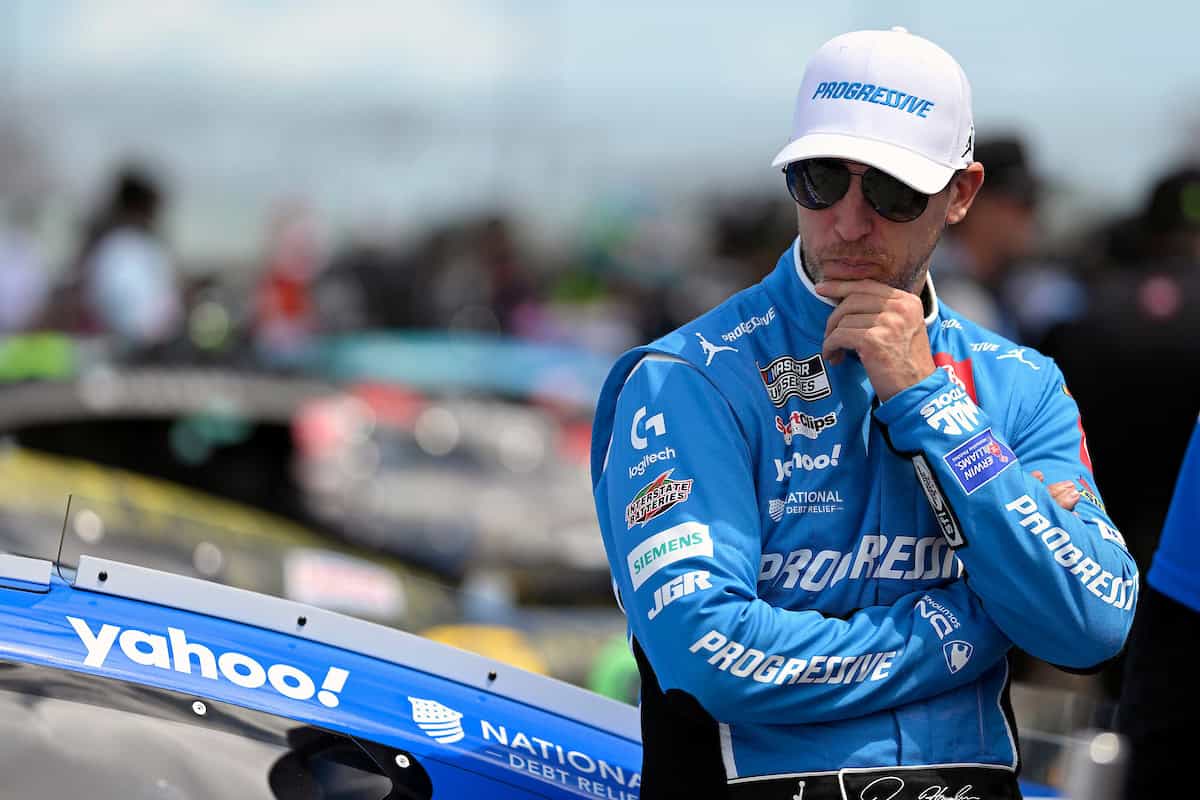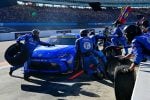Did You Notice?… They say time is supposed to be a healer. But here NASCAR sits, one week after Denny Hamlin lost his 2025 NASCAR Cup Series championship in gut-wrenching fashion, and too many people are acting like they’re still in the ER waiting room.
Hamlin has spent the last seven days in stages of grief, shock, and disappointment, even mulling retirement. His popular podcast Actions Detrimental hasn’t recorded an episode since the finale.
Poor actual champion Kyle Larson, who earned the title fair and square under the rules, has been forced to act like someone who stole those jewels in the Louvre and got away with it. NASCAR’s new postseason awards setup meant the title was quickly celebrated days after the Phoenix Raceway finale, giving Larson the trophy and a chance to exit stage right as quickly as possible. There’s a legion of fans who are still acting (again, unfairly) like the poor man committed murder.
A week out from the checkered flag, I’m not even sure half the fan base knows Ryan Blaney won the actual race. Or that he passed Brad Keselowski on the final lap to do it.
NASCAR, meanwhile, is left holding the bag on a playoff system that finally has all sides ready to take out the trash. But a much-rumored change to the format for 2026 wasn’t announced in the wake of the Phoenix desert disaster. Instead, the sickening smell still sits there, everyone forced to breathe it in while blood from the sport’s injured reputation still pools on the floor.
Oh, did I mention there’s a trial in three weeks? One that Hamlin’s involved in alongside Michael Jordan and two Cup teams whose lawsuit against NASCAR threatens to change the very landscape of the sport. That, too, remains uncertain, a potential settlement to call off the storm last week not materializing despite multiple assurances both sides were “close.”
Here’s What Happened in the 23XI/FRM vs. NASCAR Lawsuit This Week (Nov. 1-7)
Close doesn’t cut it when it comes to catastrophe. All that’s left now is cleanup and damage control, getting more difficult for all involved with each passing day the mess sits untouched.
How in the world have we gotten to this point with stock-car racing? In the span of 20 years, this sport has gone from America’s second-most-popular to causing second-degree burns, too many involved willing to set fire to whatever’s holding it together.
So much has gone wrong, but no matter your focus, bad decisions these days focus on three simple words: Rolling the dice.
As a longtime casino guy, I can understand how much fun rolling said dice can be. So can race fans: 22% of all Americans, including nearly 50% of men ages 18-49, have a sports gambling account. One of the fondest memories I have of my grandfather when I was young was teaching me craps; it’s the one game in the casino, he would say, where the odds are closest to being stacked in your favor.
But the actual act of playing craps? For anyone who’s done it, a roll of the dice takes about five seconds. If you lose, there’s no long-term emotional commitment, just an extreme high or low that wraps up 10 times faster than the Kentucky Derby.
It’s a philosophy that doesn’t quite square with a nine-month sport, filled with nearly 40 race weekends and well over 200 hours of racing across its top three series. For decades, the sport has been able to sustain that schedule due to its passionate fan base, connected enough to spend entire weekends traveling to far-off destinations like Talladega, Ala., and Las Vegas and see their drivers duke it out. Thousands of dollars of their hard-earned money are spent cheering for days.
The last thing you want is to make them feel like their fandom, years of commitment, emotional highs and lows just come down to one five-second roll of the dice.
But that’s where we’re at.
There’s the roll of snake eyes Hamlin’s crew chief Chris Gayle is still mulling over, a choice to take four tires after a caution flew for William Byron’s blown tire with less than three laps remaining. It was ultimately his pit strategy to make, overtime looming, and one Larson’s crew chief Cliff Daniels took advantage of with a two-tire call.
That allowed Larson’s No. 5 to win the title without leading a single lap. It left Hamlin’s multiple battles back from lost track position, including a blown tire, to reach the lead and perhaps the pinnacle of his 20-year career shattered into pieces.
Instead, the rules created a five-second dice roll that felt very unlike overtime in the Super Bowl, game seven of the Los Angeles Dodgers-Toronto Blue Jays World Series … you get the picture. Turns out to have a game-seven moment, you need to have the emotional connection of all the blood, sweat and tears built up to it.
Five seconds doesn’t give a lot of time for that.
And it’s not just this race. It’s the very playoff format where the final round, best-finish-among-four-drivers setup wipes out everything they’ve done in the first nine months of the year. A playoff system where, in every year since the 2014 format change, the Daytona 500 winner has clinched a spot a full seven months before the actual postseason begins.
The system necessitates that winner start the remaining 25 regular-season races. Bonus playoff points are designed to keep their head in the game. But a year-round focus on the championship makes it hard, for several months, to focus on more than the five seconds of fame that got them a spot. How can you build up a driver’s success when most of it now hinges on a postseason that’s months away?
There are also the issue of the races themselves. Drafting packs at Daytona International Speedway, Talladega Superspeedway and EchoPark Speedway where drivers have wised up to the fact no one can pull away on raw speed. It’s created fuel mileage races with plenty of lead changes on paper but a small segment of all-out competition. Sometimes it works out brilliantly and sometimes half the field is turned into a bunch of scrunched-up sheet metal; either way, you often don’t need to watch the first two hours to find out.
Denny Hamlin’s Championship Falls Apart With 1 Yellow Flag
Stage racing breaking down these events into pieces, often leaving the first stage a glorified test session? A Next Gen car whose weakness happens to be the very short tracks that serve as the proving grounds for drivers working up through the system?
We could go on and on. That’s just not how it used to be in this sport where the best drivers appeared larger than life. Dale Earnhardt’s generational dominance, along with Jeff Gordon’s that followed, came with an ability to transcend the sport, dragging in millions of new fans through sustained success. Multiple race wins and championships left the focus on them year-round, setting records that were built with a much bigger foundation than a five-second call in the pits.
Now? The all-encompassing playoffs turn feats into failures. What do people remember more: Shane van Gisbergen’s record-setting five road course wins as a rookie or a first-round postseason exit, combined with a points system that wouldn’t leave him inside the top 20 without a playoff ticket? Can people remember Connor Zilisch’s 10 NASCAR Xfinity Series wins or the fact Jesse Love bested him in a one-race battle for the title with two?
No points system is perfect. You can debate NASCAR’s intentions, but I do believe decisions are made in what they thought was the best interest of the sport. But these choices to go after game-seven moments have cheapened the result to become little more than five-second dopamine hits, an Instagram reel people are increasingly scrolling past for the next one. When you work so hard to force something to be special, it can cause people to lose sight of what the word really means.
There are fixes to these problems heading into 2026. Tweaking the playoff system while finding some way to come to terms on the lawsuit, bringing a contentious process to a close after a year-plus of fighting would be a good start.
Instead, too many stakeholders are sitting here rolling the dice, perhaps even reading this column and feeling like it’s mistaken; their roll, their strategy is ready to fix it all. But has anyone looked up to see who’s still hanging around the craps table while they wait?
Win or lose, that audience is increasingly at risk.
Follow Tom Bowles on X at @NASCARBowles
Majority Owner and Editor in Chief at Frontstretch
The author of Did You Notice? (Wednesdays) Tom spends his time overseeing Frontstretch’s 40+ staff members as its majority owner and Editor-in-Chief. Based outside Philadelphia, Bowles is a two-time Emmy winner in NASCAR television and has worked in racing production with FOX, TNT, and ESPN while appearing on-air for SIRIUS XM Radio and FOX Sports 1’s former show, the Crowd Goes Wild. He most recently consulted with SRX Racing, helping manage cutting-edge technology and graphics that appeared on their CBS broadcasts during 2021 and 2022.
You can find Tom’s writing here, at CBSSports.com and Athlonsports.com, where he’s been an editorial consultant for the annual racing magazine for 15 years.





